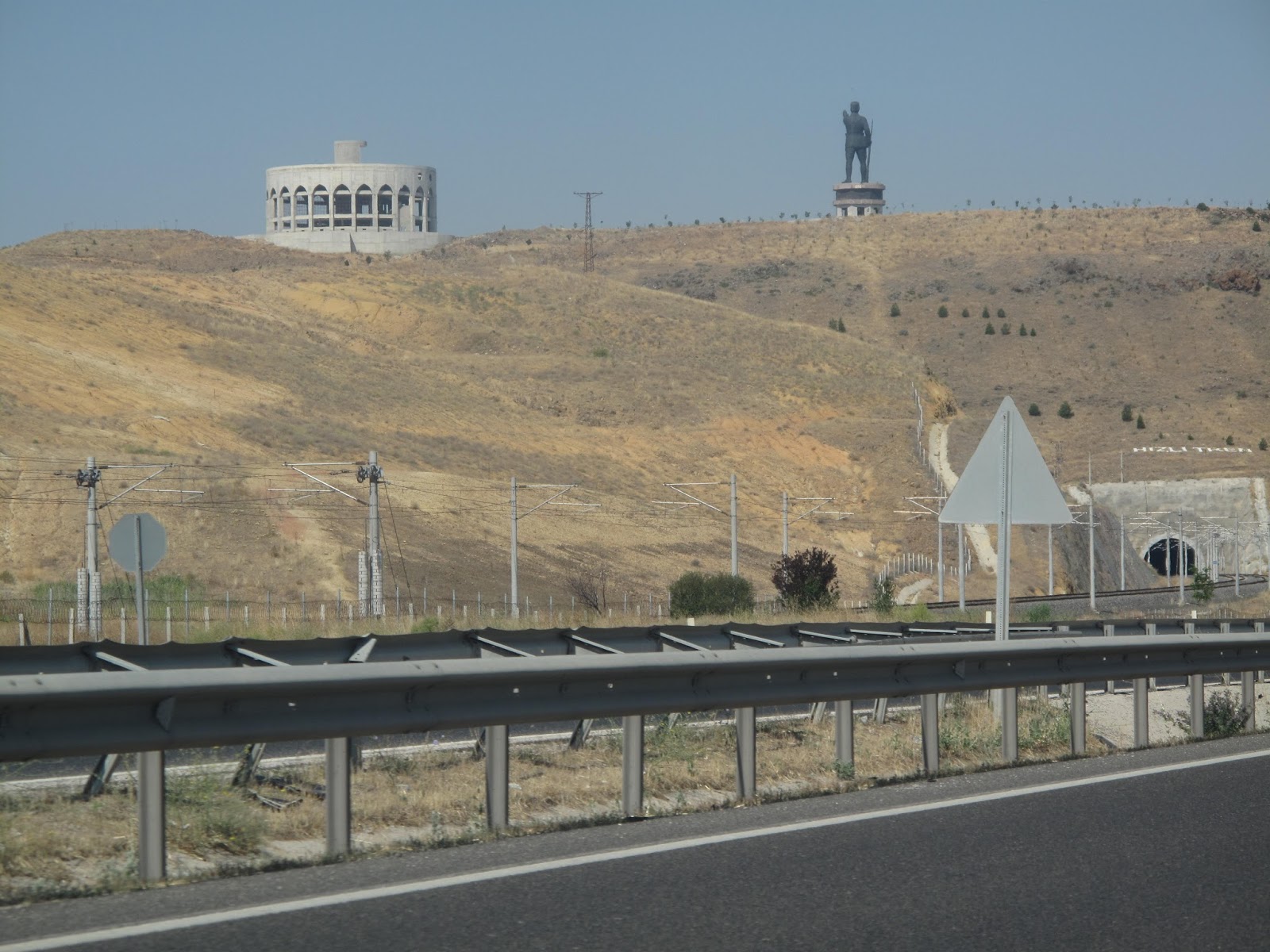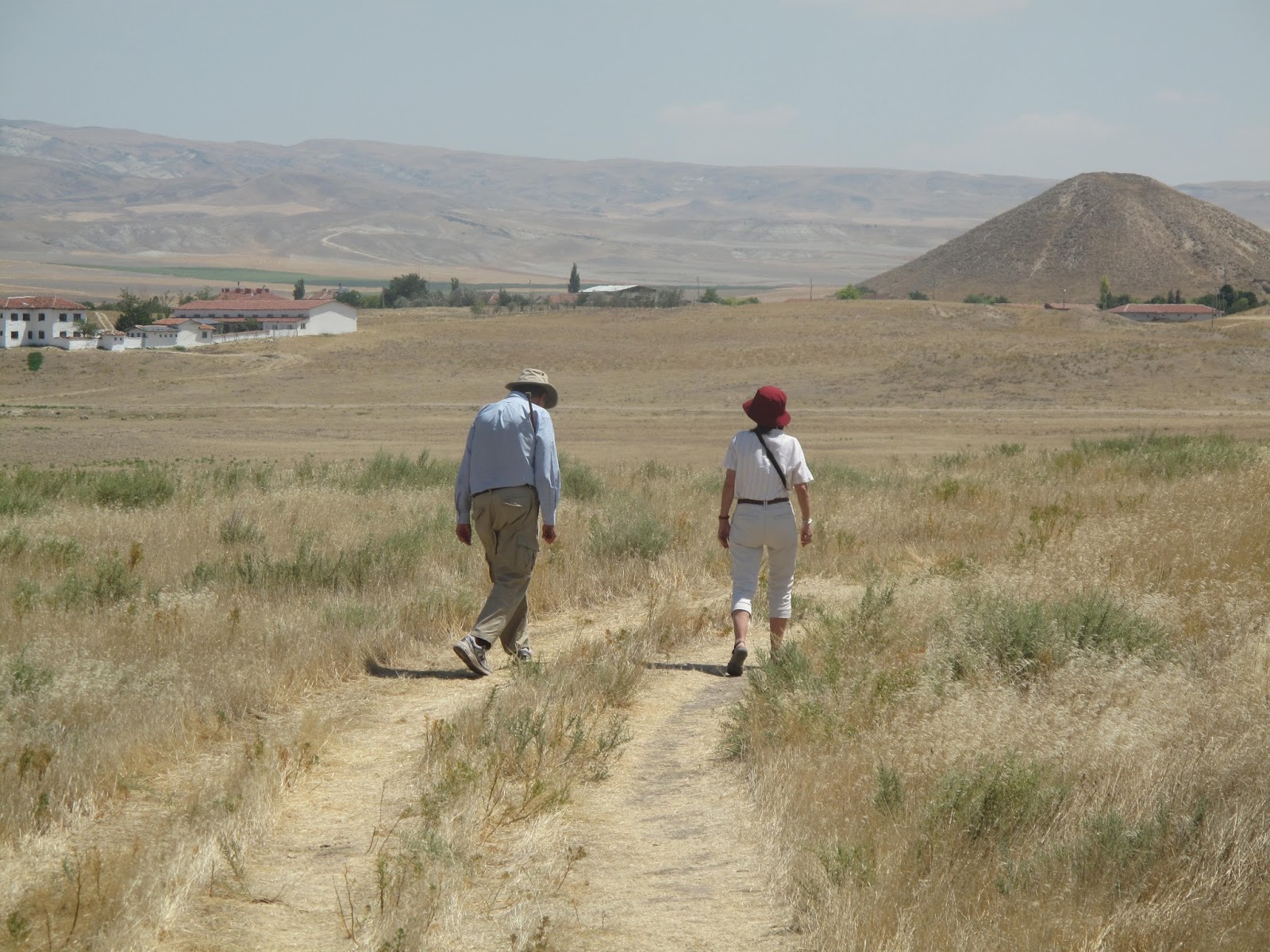The
bell rings. It is 1:00 pm, lunchtime at
the Gordion excavations. Marie-Henriette
and I leave the balcony, where we have been chatting with Ken Sams, the Gordion
Project director, and get in line for lunch.
Since I’m not on a rigorous excavation routine, my eyes are bigger than
my stomach, but I can’t resist: ezo gelin soup (a spicy lentil, bulgur, and
tomato soup); a casserole of eggplant, tomatoes, potatoes, and ground beef;
chopped tomato, cucumber, and onion salad; fresh yogurt from the village; and melon, for dessert. Turkish coffee follows.
Gordion
was the capital of the Phrygians, an Iron Age Anatolian people prominent in the
9th-7th c. BC. They were not the first
to live here, though, and after their heyday, settlement would continue for
centuries more. Excavations of the
ancient city and of the tumulus burials in the surrounding area were first
conducted by the Körte brothers, Alfred and Gustav, in 1900, and since 1950 by
the University of Pennsylvania Museum.
For understanding the Phrygians, these excavations have been
essential.
I
first visited Gordion almost 40 years ago, when I was a graduate student at the
University of Pennsylvania. Rodney
Young, the chair of the Classical Archaeology program, had been excavating
Gordion since 1950, and many department students had spent at least one summer
here. I had his agreement to take part
in the 1975 season, but sadly, he was killed in a traffic accident in 1974 and
excavations were, for the time being, stopped. Rodney Young was a gruff man; I
wonder how I would have fared had that 1975 season taken place. I have returned to Gordion off and on ever since,
but always as a visitor, for other excavation opportunities took me elsewhere. But Gordion has a special meaning, because
many friends have worked here and because it is so close to Ankara, my home
since 1990.
Even
so, I haven’t visited for several years, because the Gordion excavation season
has largely overlapped with our summer work at Kinet Höyük. Now that field work at Kinet Höyük has ended,
we are at last free to make such visits.
Marie-Henriette
and I drive west from Ankara, through the town of Temelli which has chanelled
its marshlands into two sterile-looking parks with ponds on either side of the
highway. Soon we see a cluster of
storks, swirling around, and others in the harvested fields gleaning tasty
morsels of grain. The major city en
route is Polatlı, long-time seat of an artillery school (Topçu ve Füze Okulu),
now boasting of a population over 100,000 and the wish to become its own
province, separate from (very large) Ankara.
Polatlı has had a reputation for dullness, at least among the Gordion
staff. They used to joke:
“What’s
there to do in Polatlı?”
“You’re
doing it."
Maybe
today there is more excitement in the air, more choices, although my experience
is that Turkish cities have kept the same personalities they had in the 1970s
even if their populations have tripled
or quadrupled.
An
intrepid British friend used to stay in a roadside hotel called the Piknik
Palas. In the old days, Turkish hotels
often included “palas” (“palace”) in their name, even if they were totally
unpalatial. Today, oddly, it’s no longer
fashionable to be a “palas,” even if some distinguished examples are still with
us, such as the Pera Palas in Istanbul.
We
couldn’t spot the Piknik Palas. It must
be history now.
Colossal statue, from the east
Continuing
west, we drive by the colossal statue of a soldier, or perhaps Atatürk, on the
crest of a hill, a recently erected
(2008) monument to the Turkish soldiers who fought against the Greeks in the
key Battle of the Sakarya, late summer 1921. It reminds me of the Colossus of Barletta (a
5th c. statue of an early Byzantine emperor), although much, much bigger (31 m. vs. a mere 5 m.). Coming from the east, we see him from the
back, for he is facing west, gesturing “Stop, no further!” to the Greek army which
had made it inland this far.
The
turn-off from the highway takes us into another world. Even if the track of the high-speed train to
Eskişehir crosses above the one-lane road, we’re in traditional Anatolia, with
a few farm houses; an abandoned old-fashioned ochre-painted railway station; fields
of grain, yellow as they always are in mid-summer, and only the random tractor or car on the road.
In
the distance we see the Phrygian tumuli scattered here and there. Most were robbed, in antiquity or recent
times, but a few, including the largest of all, the so-called Midas Monument
located on the outskirts of the village of Yassıhöyük, survived intact. The Midas Monument was opened in 1957, its
tomb chamber, a log cabin sealed with rocks and clay, containing the skeleton
of a mature man lying on a bed, surrounded by countless bronze bowls and
cauldrons and intricate, inlaid wooden furniture.
We
drive into the courtyard of the excavation house, a traditional two-storied
village house that I am guessing was built in the 1950s during the Rodney Young
years. Ken comes to greet us, and shows
us the latest addition, a large depot, like a small warehouse, where finds from
many seasons will be stored for the researchers and conservators who will study
and preserve them. The spectacular finds
go immediately to the Museum of Anatolian Civilizations in Ankara; here are
kept fragments, worth scientific study but not necessarily museum display.
Gordion excavation house: a work room
Inside
we meet our friend Ayşe, who is conducting ethnoarchaeological research. Copies of a recent issue of a Polatlı
newspaper are lying about; on its front page is an article about her
investigations. Mention is made of a Dr.
C. Brain. He turns out to be none other
than C. Brian Rose, a professor of archaeology at the University of
Pennsylvania and Ken’s designated successor as
project director (pending government approval), also working at Gordion
this summer.
New excavations (summer, 2013)
Ken
takes us to the settlement mound to show us the latest excavations, a section
of the Phrygian fortification system, and, from a distance, the conservation
work on early Phrygian buildings, an effort that goes on every year, with new
techniques tried, a huge effort to preserve wall foundations made of sun-dried
mudbricks in a climate which is harsh, with snow in the winter, rainstorms in
the spring, and hot dry sun in the summer.
New fencing has been installed, replacing rusty, gnarled barbed wire
that despite its neglected appearance still performs its job of keeping
visitors from entering the excavation areas.
New explanatory panels have been put up, conforming to the
specifications of the Culture Ministry.
They look great, but they too will surely have to be replaced in a few
years after the weather has taken its toll.
After
lunch, we take our leave and head for Polatlı on the back road. We will miss the colossal statue of Atatürk,
but we will see instead, from the distance, a tumulus – perhaps with its burial
intact – under investigation at this very moment by the Museum of Anatolian
Civilizations lest ever-vigilant tomb robbers get in first. We drive by “hobby gardens,” plots of land in
the middle of nowhere where apartment-dwelling Polatlians can come grow
vegetables and flowers. And just before
we enter the city we see the monument for the Battle of the Sakarya,
celebrating the 1921 victory against the Greeks. It looks like the double spine of a dinosaur,
slowly cascading down the hillside. In
all these years, I have never stopped to visit it. Next time, I should.
For the Gordion Excavations: http://sites.museum.upenn.edu/gordion/








No comments:
Post a Comment